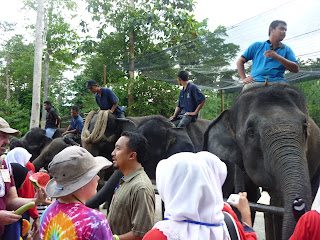WHAT IS LABU SAYONG?
The original Labu Sayong is a black gourd-shaped clay pitcher used for containing drinking water. The idea originated from the use of actual matured pumpkins to store water, after the contents had been removed and the inside cleaned.
It is believe that the water stored in Labu Sayong help prevent many illnesses and stomach disorders. No research has been done on this medical value. Anyway, it is very important to drink lots of water each day.
WHERE?
There are numerous Labu Sayong Enterprises in Kg Sayong, Kg Bukit Lada, Kg Pauh, Kg Sayong Ketengah and Kg Kepala Bendang approximately 15 kilometers from The Royal Town of Kuala Kangsar from the Northern State of Perak, Malaysia. The Malaysian Government is promoting this Cottage Industry as part of their SDSI (Satu Daerah Satu Industri) program literally translated as One District One Industry. The Perak branch of the Malaysia Handicraft Development Corporation has opened a Handicraft Centre at a nearby town of Enggor which offers a training course in the making of Labu Sayong apart from selling these useful and attractive products.
THE PROCESS OF MAKING LABU SAYONG
STEP 1 – PREPARING THE CLAY SOIL
The clay found along streams and river banks at Sayong River is most suitable to make the Labu Sayong. Traditionally, this clay is left to dry under the sun for days. It is first pounded into extremely fine powder and then sieved from coarser remains and wood to obtain the finest and cleanest clay. Water is then added to this clay powder and kept in a container for a few days. During this process, the clay will settle down, The water is then removed and the remaining clay is taken out and put on a plaster slab to be kneaded and wedged. This process of kneading and wedging will remove air bubbles which can cause the pot to break when exposed to intense heat. After that, it is shaped into its distinct traditional 'double-bulb' shape. Such tedious and painstaking process!!!
Nowadays, the clay soil is mixed with Sodium and water in a simple improvised machine to produce a batter.
STEP 2 - MOULDING
The batter is pour into the mould. Let it set inside the mould for 3 hours or so depending on the weather. The bigger pot usually takes one day or so. The pot is removed from the mould and turn upside down to dry.
STEP 3 - SHAPING AND DESIGNING
The process of shaping and decorating is done on a simple rounded wooden board wheel rotated by hand.
STEP 4 - DRYING
The pots are then dried in the sun for 3 days or so to harden the surface.
STEP 5 – BAKED
Back in the old days, the pots are fired in open trenches filled with dry rambutan trees, bamboo and palm fronds until they are red hot. They are immediately removed and placed on a pile of paddy husk or saw dust for 20 minutes to impart the black sheen. The base of the pot is brushed with liquid resin or wax to render it waterproof. Imagine all those opening burnings, sweats and hard work!!!
Nowadays, the pots are baked in a kiln at temperature of 1000 centigrade for 10 hours or so depending on the size and purpose. The longer the baking, the more expensive it is. However the original black Labu Sayong is still processed the traditional ways
STEP 6 – FINAL TOUCH
Till this day, Labu Sayong is greatly admired, not only for its utility, but for its beauty and aesthetic quality. Beside the water pitcher, Labu Sayong can be made into lamp stands and vases. To produce the different, beautiful and unique looks, different techniques are used.
For a greenish look, the pot is sprayed with Meranti liquid. Generally, this type of vase cost RM 6.00 per small piece, RM 45.00 per medium piece and RM 95.00 per large piece. Of course, the price will be more expensive for more intricate design.
For the earthen look, it is dipped in the natural wood-colored paint. Otherwise, the pot is painted over its natural baked state.
For the glossy and varnished look, it is glazed with liquid resin.
Lamp Shade is the most sought after decorative item. The price ranges from RM 48.00 to RM 95.00 per piece with or without base, wiring and lamp shade.
5 easy steps to clean and use the Labu Sayong water pitcher.
Step 1 - Rinse the inside with plain water to clean the clay
Step 2 – Wash the rice thoroughly. Keep the 1st washed water.
Step 3 - Rinse the inside of the Labu Sayong again with the ‘rice water’.
Step 4 - Turn it upside down and leave it to dry for 24 hours.
Step 5 – Now it ready to use. Enjoy!!
If you wish to witness this famous handicraft-making cottage industry in Perak and is mainly found in Kuala Kangsar, please contact Wan at 603-2260 2667/ 3667 / 4667 fax 603-2260 5667 or email your request to leisureincentivetours@gmail.com. I could also organize a visit several places of interest in the royal town of Kuala Kangsar, mainly the ‘Istana Kenangan’. Originally a royal residence, this 1926 timber building was constructed without the use of nails and converted in a Royal Museum which displays Perak’s royal regalia as well as pictures and depicts then history of the royal family. Another beautiful historical landmark is the Ubudiah Mosque which was constructed at the turn of the century by the 28th ruler of Perak, Sultan Idris Mursyidul Azam, with its magnificent golden domes and minarets.
There are more pictures in our Facebook. www.facebook.com/Leisure-Incentive-Tours-Sdn-Bhd
There are more pictures in our Facebook. www.facebook.com/Leisure-Incentive-Tours-Sdn-Bhd
















































































